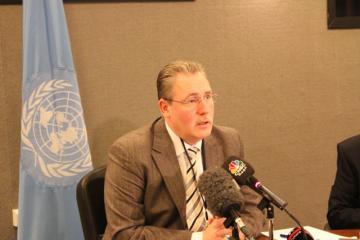
Abdallah AlDardari, Director, ESCWA Economic Development and Globalization Division and Chief Economist, today said Economic situation of the Arab region can be characterized by its polarizing economic performance between major energy exporters and other Arab countries. Major energy exporters, mainly of GCC countries, have registered a stable growth with constantly growing domestic demand through active fiscal policy. On the other hand, political instability and social unrest clouded economic situation of other Arab countries, namely Mashreq, Maghreb and Arab Least Developed Countries.
AlDardari was speaking at a press conference he held to launch a UN flagship annual report, "The World Economic Situation and Prospects 2013 (WESP)," ESCWA headquarters, Riad El-Solh Square, Beirut. "GDP growth in Western Asia region declined from 6.7 per cent in 2011 to 3.3 per cent in 2012, and it is forecast to stagnate in 2013 before picking up to 4.1 per cent in 2014," he said.
Produced at the beginning of every year by the UN Department of Economic and Social Affairs (UN/DESA), the United Nations Conference for Trade and Development (UNCTAD) and the five United Nations regional commissions, the UN report said most oil-exporting countries benefitted from record-high oil prices and rising oil output in 2012, especially Iraq, Kuwait and Saudi Arabia. Public and private investments bolstered growth in Qatar. Economic activity grew more modestly in Bahrain, Oman and the United Arab Emirates. Political instability delayed any possible recovery in Yemen and degenerated into civil war in the Syrian Arab Republic, weighing on risk perception in the entire region. Neighbouring Jordan and Lebanon were further affected by subdued cross-border economic activities, including trade, investment and tourism.
Syrian Crisis
AlDardari also discussed the economic situation in Syria, which was given an important part in this year's report. He said that the Syrian conflict inflicted significant economic damage, including the destruction of commercial and residential properties, infrastructures and production facilities. Economic sanctions also negatively impacted the Syrian economy. The oil embargo caused an export revenue loss of about $4 billion, cutting government revenue by around 25 per cent in 2012.
He noted that bilateral trade flows between the Syrian Arab Republic and neighbouring countries decreased substantially in the first half of 2012, with the exception of Lebanon. The transit of goods through Syrian territory almost stopped, diverting to alternate routes.
Jordan and Lebanon were especially affected by subdued cross-border economic activities with Syria. Capital inflows and tourism, which were recent drivers of economic expansion in those countries, decreased significantly due to the crisis, AlDardari underlined.
In response to what the region has been witnessing, AlDardari called for achieving regional integration as the only path to reach sustainable human development. He reiterated ESCWA's call to achieve regional integration as a sound economic solution for countries of the region, since the latest crises have shown that the Arab region was more connected than previously believed. The crises were indeed felt in the region as a whole.
Employment
Social unrest associated with the Arab Spring surged in part because of the weak absorption capacity of labour markets across the region, which generates unemployment, underemployment and vulnerable employment. Relatively low official unemployment rates disguise the true extent of underutilization of labour because of low participation rates, especially among women.
Governments of GCC and other countries responded to social unrest by raising wages and creating new jobs in the public sector, including by strengthening security forces, and extending the social safety net. In Saudi Arabia, for instance, the unemployment scheme created in the wake of the Arab Spring, attracted more than a million unemployed workers, many of them women not previously considered part of the labour force.
Meanwhile, labour markets remain highly segregated in GCC countries. Migrant labour still represents about 90 per cent of the private sector work force, as a consequence of uncompetitive compensation compared to the public sector and poorly coordinated education and industrial policies that result in a skills mismatch.





